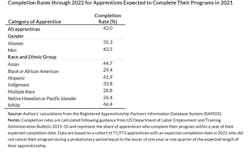Electricians are highlighted in a couple of new studies examining the mounting challenge of finding enough workers in the skilled trades.
New McKinsey & Co. research into the growing skilled trades labor squeeze ranks electrician near the top on a list of trades employers will find difficult to keep filled over the next decade. And new research commissioned by the U.S. Department of Labor on the role of apprenticeships in promoting diversity in construction shows electrical apprenticeships have by far the highest enrollment and the lowest starting wage, but unexpectedly strong representation by women, Blacks, and Hispanics.
Both studies speak from different angles to growing construction industry unease about the ability to recruit, replace, hire, and retain qualified workers.
Focusing on a blend of new job openings, retiring workers, job/career changers, loss of experienced workers, and recruiting/training challenges, the McKinsey report predicts that hiring to fill a dozen “critical” skilled trade roles (like electrician) will be all-consuming work. Analyzing U.S. Bureau of Labor Statistics data, McKinsey predicts annual hires for those roles between 2022 and 2032 will average almost 585,000 — some 22 times more than the expected annual net new jobs average of 26,600.
“This extraordinary rate of churn could cost companies more than $5.3 billion every year in talent acquisition and training costs alone,” the report states. “The additional lost productivity as new talent is brought up to speed could amount to significantly more.”
It identified electricians as a skilled role that will likely suffer from comparatively high churn. By 2032, it’s estimated that there will be 812,000 electricians employed, up from an estimated 763,000 in 2022. But by that year, only 72,000 will have been in that role continuously from 2022. Retirements requiring replacements will number 230,00, while 460,000 slots will have to be continually filled because of job and career changers. Net new jobs will number 50,000. In sum, 740,000 jobs will result from new hires (Fig. 1).
The trade’s heavy reliance on lengthy apprenticeships will affect the ability of employers to fill those jobs. Running up to five years in duration, apprenticeships keep a stream of electricians coming. But dropouts reduce that number while slow skills development impact productivity. McKinsey pegs the annual electrician retirement rate at 23,000, slightly below the estimated 2023 apprenticeship program completions of 29,600.
The pipeline of talent for the craft also is hampered by low numbers of employed women and minorities, groups employers will likely have to tap more aggressively to fill openings. With women accounting for 2% of electricians in 2021 and non-whites at 23% of the electrician workforce, “this lack of diversity could further inhibit overall skilled-workforce growth.”
But the Labor Department construction apprenticeship research, done by the Urban Institute, finds glimmers of hope that the trades will become more diverse over time. In 2022, the report says, both women and Black workers’ rate of participation in apprenticeship programs for 18 of 23 construction occupations was higher than their share of the that occupation’s total workforce, while it was 11 of 23 for Hispanics.
The positive apprenticeship participation-employment gap was pronounced in several occupations, but it fell in the middle for electricians, the trade with the largest apprenticeship enrollment but also the lowest median starting hourly wage for apprentices: $15. Of 115,471 active electrician apprentices in 2022, 4.55% were women, double their 2.28% share of the electrician workforce. Blacks had an 8.05% share of apprenticeship participation, slightly higher than their 7.03% share of the electrician workforce. Hispanics’ share was almost equal: 19.75% of apprenticeships and 19.60% of the workforce.
Data showing apprenticeship participation higher than workforce share for specific groups point to a potential opening for increased hiring in specific trades, the report states. Across multiple construction occupations analyzed, programs employed 87% more women and 43% more Blacks than they would have if the rate mirrored their representation in the occupation. The takeaway on women, specifically, is that data “suggest apprenticeship programs are doing a better job of recruiting women into the construction trades than construction companies are in general.” Yet, program completion is a problem. The report cites data showing that non-white male participants in all apprenticeships may complete programs at a lower rate (Fig. 2).
Citing data showing that construction apprenticeship participation by women and people of color increased between 1999 and 2019, and that almost half of all active apprentices in the economy in 2022 were construction-related — a third of which were electrician — the report authors say interest in training for construction careers may be strong among groups the industry needs to court.
“If the utilization of women and people of color in apprenticeship programs is meaningfully or substantively higher than it is in the national workforce of the corresponding occupation, it suggests that scaling or expanding apprenticeship may be a strategy for improving their overall utilization in construction.”
About the Author
Tom Zind
Freelance Writer
Zind is a freelance writer based in Lee’s Summit, Mo. He can be reached at [email protected].


